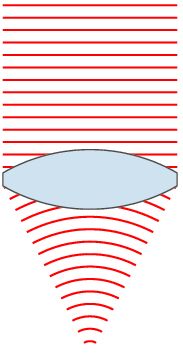Ofbyld:Lens and wavefronts.gif
Lens_and_wavefronts.gif (183 × 356 pixels, bestânsgrutte: 35 KB, MIME-type: image/gif, looped, 9 frames, 0,7 s)
Triemskiednis
Klik op in datum/tiid om it bestân te besjen sa't it op dat stuit wie.
| Datum/Tiid | Miniatuer | ôfmjittings | Meidogger | Opmerking | |
|---|---|---|---|---|---|
| lêste | 25 nov 2007, 08.35 |  | 183 × 356 (35 KB) | Oleg Alexandrov | tweak |
| 24 nov 2007, 06.10 |  | 171 × 356 (33 KB) | Oleg Alexandrov | tweak | |
| 24 nov 2007, 06.09 |  | 171 × 356 (33 KB) | Oleg Alexandrov | tweak | |
| 24 nov 2007, 02.56 |  | 171 × 359 (33 KB) | Oleg Alexandrov | tweak, same license | |
| 24 nov 2007, 02.53 |  | 171 × 359 (32 KB) | Oleg Alexandrov | tweak | |
| 24 nov 2007, 02.49 |  | 151 × 359 (31 KB) | Oleg Alexandrov | {{Information |Description=Illustration of wavefronts after passing through a [:en:lens (optics)|lens]] |Source=self-made with MATLAB |Date=~~~~~ |Author= Oleg Alexandrov |Permission=see below |other_versions= }} |
Bestânsgebrûk
De neikommende side brûkt dit bestân:
Globaal bestânsgebrûk
De neikommende oare wiki's brûke dit bestân:
- Gebrûk op ar.wikipedia.org
- Gebrûk op ast.wikipedia.org
- Gebrûk op be.wikipedia.org
- Gebrûk op bn.wikipedia.org
- Gebrûk op bs.wikipedia.org
- Gebrûk op ckb.wikipedia.org
- Gebrûk op cs.wikiversity.org
- Gebrûk op cv.wikipedia.org
- Gebrûk op en.wikipedia.org
- Gebrûk op en.wikiversity.org
- Gebrûk op es.wikipedia.org
- Gebrûk op es.wikiversity.org
- Gebrûk op eu.wikipedia.org
- Gebrûk op fa.wikipedia.org
- Gebrûk op fi.wikipedia.org
- Gebrûk op fr.wikipedia.org
- Gebrûk op fr.wikibooks.org
- Gebrûk op ga.wikipedia.org
- Gebrûk op he.wikipedia.org
- Gebrûk op hi.wikipedia.org
- Gebrûk op hr.wikipedia.org
- Gebrûk op hy.wikipedia.org
- Gebrûk op id.wikipedia.org
- Gebrûk op lt.wikipedia.org
- Gebrûk op lv.wikipedia.org
- Gebrûk op ml.wikipedia.org
- Gebrûk op mn.wikipedia.org
- Gebrûk op nl.wikipedia.org
- Gebrûk op pa.wikipedia.org
- Gebrûk op ru.wikipedia.org
- Gebrûk op sh.wikipedia.org
- Gebrûk op si.wikipedia.org
- Gebrûk op sl.wikipedia.org
- Gebrûk op sr.wikipedia.org
- Gebrûk op sv.wikipedia.org
- Gebrûk op ta.wikipedia.org
Mear globaal gebrûk fan dit bestân besjen.


